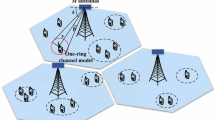Abstract
In this paper, the performance of the cell free Massive multiple-input multiple-output (MIMO) system with realistic channel impairment conditions is discussed. The channel impairment conditions arise due to various issues like the pilot contamination, high speed user mobility, accumulated phase noise and Doppler shifts etc. At first, we provided a system model with channel aging due to Doppler shift, during uplink and downlink for channel estimation and data transmission. An optimization objective problem is formulated to improve the joint spectral efficiency during both uplink and downlink. The primary objective problem is partitioned into two different sub-problems, which are solved by a user defined joint frame allocation and user matching (JFAUM) algorithm based on efficient allocation of pilot resources and matching techniques for user clustering. Finally, the numerical results prove the improvement in spectral efficiency of massive MIMO system by using the proposed JFAUM algorithm under various practical conditions.





Similar content being viewed by others
References
Panda, S. (2020a). Joint user patterning and power control optimization of MIMO–NOMA systems. Wireless Personal Communications, 112, 2557–2573.
Lu, L., et al. (2014). An overview of massive MIMO: Benefits and challenges. IEEE Journal on Selected Topics in Signal Processing, 8(5), 742–758.
Tseng, S. M., Chen, Y. F., & Liu, K. C. (2019). Cross layer power control and user pairing for DL multi-antenna NOMA. Wireless Personal Communications, 109(3), 1541–1556.
Panda, S. (2018a). Performance optimization of cell-free massive MIMO system with power control approach. International Journal of Electronics and Communications (AEU), 97, 210–219.
Bazzi, S., et al. (2017). Downlink training sequence design for FDD multiuser massive MIMO systems. IEEE Transactions on Signal Processing, 65(18), 4732–5744.
Larsson, E. G., et al. (2014). Massive MIMO for next generation wireless systems. IEEE Communications Magazine, 52(2), 186–195.
Narasimhan, T., et al. (2014). Channel hardening-exploiting message passing (CHEMP) receiver in large-scale MIMO systems. IEEE Journal of Selected Topics in Signal Processing, 8(5), 847–860.
Yin, H., et al. (2013). A coordinated approach to channel estimation in large-scale multiple-antenna systems. IEEE Journal on Selected Areas of Communication, 31(2), 264–273.
Papazafeiropoulos, A. K. (2017). Impact of general channel aging conditions on the downlink performance of massive MIMO. IEEE Transaction on Vehicular Technology, 66(2), 1428–1442.
Kong, C., et al. (2015). Sum-rate and power scaling of massive MIMO systems with channel aging. IEEE Transactions on Communications, 63(12), 4879–4893.
Panda, S. (2018b). Performance improvement of clustered wireless sensor networks using swarm based algorithm. Wireless Personal communications, 103(3), 2657–2678.
Panda, S. (2020b). Performance improvement of Massive MIMO system under rapid user mobility conditions. Computer Communications, 156, 112–123.
Wu, W., et al. (2018). Beam domain secure transmission for massive MIMO communications. IEEE Transactions on Vehicular Technology, 67(8), 7113–7127.
Palomar, D. P., et al. (2006). A tutorial on decomposition methods for network utility maximization. IEEE Journal on Selected Areas in Communication, 24(8), 1439–1451.
Schrijver, A. (1998). Theory of linear and integer programming. Hoboken, NJ: John Wiley & Sons.
Panda, S. (2020c). Energy efficient routing and lightpath management in software defined networking based inter-DC elastic optical networks. Optical Fiber Technology, 55, 102128.
Roth, A., & Sotomayor, M. (1992). Two-sided matching: A study in game-theoretical modelling and analysis. England: Cambridge University Press.
Acknowledgements
The author would like to extend his sincere appreciation to the All India Council of Technical Education (AICTE) for the funding of this research through the research project number 22/AICTE/WSN/RPS (POLICY-III) 2/2017-18.
Author information
Authors and Affiliations
Corresponding author
Additional information
Publisher's Note
Springer Nature remains neutral with regard to jurisdictional claims in published maps and institutional affiliations.
Rights and permissions
About this article
Cite this article
Panda, S. Spectral Efficiency Optimization of Massive MIMO System Under Channel Varying Conditions. Wireless Pers Commun 117, 1319–1335 (2021). https://doi.org/10.1007/s11277-020-07924-9
Accepted:
Published:
Issue Date:
DOI: https://doi.org/10.1007/s11277-020-07924-9




